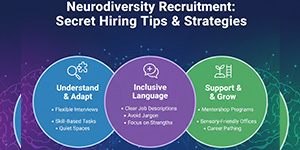What is Job Enrichment, Advantages and Importance with Example
In the ever-changing business world of today companies perpetually search for new andeffective strategies to improve worker satisfaction performance and retention. The use of job enrichment is one such successful approach.
It not only adds meaning and depth to an employee’s role but also fosters motivation and engagement. But what is job enrichment exactly and what distinguishes it from other methods of job design?
In this article, we’ll explore the concept of work enrichment, analyze its benefits, recognize its significance in HRM and also provide practical examples to help ensure its effective application.
What is Job Enrichment?
Job enrichment is a human resource strategy that aims to improve an employee's work by giving them more autonomy, variety, responsibility and opportunities for personal development. Unlike routine or monotonous roles, enriched jobs challenge employees and enable them to develop their skills.
What is Job Enrichment in HRM?
In Human Resource Management (HRM), work enrichment plays a vital role in job design. The program's primary objective is to increase job satisfaction by giving workers the opportunity to take on increasingly difficult tasks, engage in decision-making, and observe the outcomes of their labor. This increases job satisfaction and contributes to better organizational performance.

How Job Enrichment Works: Step-by-Step Guide
Implementing work enrichment incorporates a methodical approach. For HR professionals and managers here is an easy-to-read guide:
Step 1: Job Analysis
- Evaluate your current work function and identify any areas that need extension or improvement.
- Assess the worker's aptitudes, passions and level of preparation for increased responsibility.
Step 2: Add Meaningful Tasks
- Assign major assignments that directly contribute to the company's goals.
- Allow employees to take part in planning and problem-solving activities.
Step 3: Provide Autonomy
- Give employees control over how they perform their tasks.
- Reduce micromanagement and encourage self-direction.
Step 4: Create Feedback Mechanisms
- Implement regular feedback methods to ensure that employees understand how they are performing.
- Encourage two-way communication to ensure ongoing advancement.
Step 5: Opportunities for Growth
- Provide training and development initiatives.
- Create opportunities for progression inside the company.
Advantages of Job Enrichment
The advantages of job enrichment are numerous benefits the company as well as the worker. The main advantages are listed below:
For Employees:
- Increased Motivation: Challenging work increases intrinsic motivation.
- Skill Development: Enriched jobs promote learning and also personal growth.
- Higher Job Satisfaction: Employees feel valued and recognized.
- Ownership and Accountability: Employees take pride in their roles.
For Organizations:
- Increased Productivity: Motivated workers produce more.
- Better Retention Rates: By increasing job satisfaction enrichment lowers turnover.
- Enhanced Innovation: Creative solutions are frequently offered by engaged staff members.
- A stronger team culture fosters cooperation and a feeling of direction.
What is the Goal of Job Enrichment?
The primary goal of work enrichment is to create meaningful work that satisfies employees’ psychological needs. Better involvement, lower absenteeism and improved performance are the results of this.
Job Enrichment and Job Enlargement: Key Differences
While job enrichment and job enlargement are both popular strategies in job design they differ in purpose and execution also. The goal of job augmentation is vertical extension which gives an employee's current responsibilities more depth and accountability.
It seeks to increase autonomy, permit decision-making and promote personal development in order to make work more meaningful. On the other hand, job enlargement emphasizes horizontal expansion by adding more tasks of a similar level to an employee's role. While this can reduce monotony, it doesn't necessarily increase the complexity or challenge of the job.
Simply put, work enrichment enhances the quality and depth of work, leading to higher motivation and engagement, job expansion, on the other hand adds more labor without essentially altering its nature. Determining the best way to create positions that enhance organizational performance and also employee satisfaction requires an understanding of this distinction.
Job Enrichment Increases What?
You may be wondering, work enrichment increases what exactly? The answer lies in how this strategy transforms not just the nature of work but also the mindset of the employee. Fundamentally, work enrichment increases employee engagement by providing labor a higher purpose and connecting it to overall organizational objectives. People naturally become more invested in the results of their job when they are given the opportunity to take responsibility for their duties.
In addition, job enrichment increases job satisfaction. Workers now feel appreciated, trusted and empowered rather than like cogs in a machine doing monotonous work. One of the main factors influencing long-term motivation and morale is the sense of purpose that people get from having richer roles.
Another area where job enrichment increases results is productivity and efficiency. When employees are equipped with greater autonomy and more complex responsibilities, they tend to take initiative, make better decisions, and approach tasks with a problem-solving mindset. This enhances teamwork and overall organizational success in addition to improving individual performance.
Moreover, employment enrichment improves dedication to corporate goals. The mission and goals of the organization are more likely to be supported by workers who are personally fulfilled in their positions. They go above and beyond striving for perfection because they are passionate about their profession and its impact.
Job Enrichment Example: Real-Life Use Cases
Let’s explore two practical job enrichment examples that show how it can transform workplaces:
Example 1: Tech Company – Software Developer Role
A developer was given the chance to oversee a new feature project while they were working on monotonous coding jobs. The business offered mentorship possibilities, permitted the developer to oversee schedules and promoted design feedback. This job enrichment initiative led to:
- Increased job satisfaction
- Improved project delivery
- Enhanced leadership skills
Example 2: Retail Industry – Store Associate Role
A retail store associate was assigned new responsibilities like managing inventory and training new hires. With greater responsibility and autonomy the associate became more engaged and showed consistent improvement in customer service ratings.
These work enrichment examples highlight how simple changes can lead to major improvements in performance and morale.
Why Job Enrichment Matters: Importance in the Modern Workplace
The importance of job enrichment extends beyond worker pleasure, it influences business culture and promotes sustained success. This is why it's crucial:
- Aligns Individual and Organizational Goals: Employees contribute more when their personal growth aligns with the company's mission.
- Promotes Accountability: Higher performance standards result from autonomy's attendant responsibilities.
- Supports Talent Retention: Top performers remain engaged and devoted when given enriched positions.
- Encourages Innovation and Adaptability: Employees with more authority frequently welcome change and provide fresh concepts also.
What is Job Enrichment in HRM? (Recap)
It is a proactive HR approach that ensures employees are not just working, they’re growing, contributing and thriving.
Conclusion
Understanding what is job enrichment and how to implement it effectively is crucial for building a motivated, skilled, and productive workforce. Being an HR specialist, manager or company owner, the performance and satisfaction of your staff can be greatly improved by accepting work enrichment.
To sum up, work enrichment empowers employees by expanding their responsibilities and giving them meaningful work also. It differs from job enlargement by focusing more on the depth and complexity of tasks rather than just increasing the number of duties.
The advantages of job enrichment include higher motivation stronger skill development and improved retention. With real-world job enrichment examples it's clear that thoughtfully enhancing roles can lead to significant improvements in engagement and also overall organizational performance.
So, what is the goal of work enrichment? It’s simple: to create work that matters.
Read More: Job Hopping in Cambodia: What Employers Really Think





